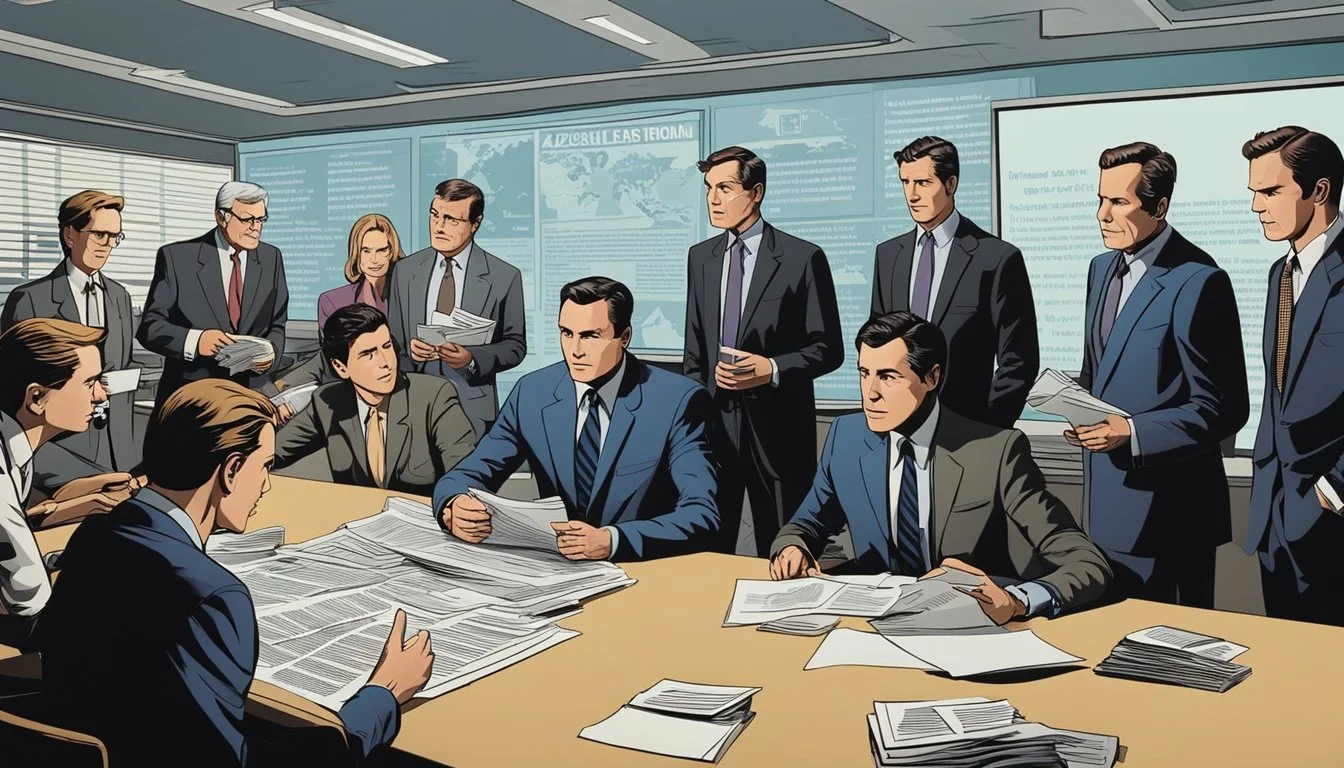Uncovering Cold War Secrets Through Press Reports on CIA Project Azorian
Project Azorian, a classified CIA operation to recover a sunken Soviet submarine, became one of the most intriguing Cold War stories when it was exposed by the press in 1975. The covert mission involved the construction of a massive ship, the Hughes Glomar Explorer, under the guise of deep-sea mining research.
Despite the CIA's efforts to maintain secrecy, journalist Jack Anderson revealed details of Project Azorian on national television and radio in March 1975, sparking widespread public interest and debate. This disclosure highlighted the delicate balance between national security and freedom of the press, raising questions about the media's role in reporting on classified information.
The exposure of Project Azorian demonstrated the challenges intelligence agencies face in keeping large-scale operations under wraps in a free society. It also showcased the power of investigative journalism to bring hidden government activities to light, even when they involve sophisticated cover stories and cutting-edge technology.
The Genesis of Project Azorian
Project Azorian emerged from Cold War tensions and a rare opportunity for intelligence gathering. The CIA's ambitious plan aimed to recover a sunken Soviet submarine from the ocean floor.
Cold War Context
The 1960s saw heightened tensions between the United States and Soviet Union. Both superpowers sought technological and military advantages. Intelligence gathering became crucial in this climate.
The CIA, under the leadership of its Director of Central Intelligence, played a key role in these efforts. Naval intelligence took on particular importance as submarine technology advanced.
The Discovery of K-129
In March 1968, the Soviet submarine K-129 disappeared in the Pacific Ocean. The U.S. Navy detected an underwater explosion near Hawaii. This event piqued American interest.
The Office of Naval Intelligence (ONI) pinpointed K-129's location northwest of Hawaii. The sunken submarine potentially held valuable intelligence assets. These included cryptographic materials and nuclear weapons.
Initiating the Recovery Effort
CIA leadership saw an opportunity to gain significant intelligence advantages. In 1969, the agency began planning a covert operation to recover K-129.
The project faced immense technical challenges. The submarine lay at a depth of 16,500 feet. No existing technology could recover an object of that size from such depths.
The CIA partnered with billionaire Howard Hughes as a cover. They created an elaborate story about deep-sea mining to mask the true purpose of the recovery vessel.
Unlikely Partnerships
Project Azorian relied on secretive collaborations between the CIA and private companies to maintain its cover. These partnerships were crucial for developing the specialized technology and maintaining the operation's secrecy.
Howard Hughes and the Summa Corporation
Howard Hughes's Summa Corporation played a pivotal role in Project Azorian. The CIA approached Hughes to provide a credible cover story for the Glomar Explorer's construction and mission.
Hughes's reclusive nature and history of eccentric projects made him an ideal partner. The billionaire's involvement lent authenticity to the cover story of deep-sea mining.
Summa Corporation managed the public-facing aspects of the project. They handled media inquiries and maintained the facade of a commercial venture.
Collaboration with Global Marine
Global Marine, a leader in offshore drilling, was another key partner in Project Azorian. The company's expertise was essential for designing and building the Glomar Explorer.
Global Marine worked closely with the CIA to develop the ship's unique capabilities. They created innovative systems for deep-sea recovery operations.
The partnership allowed for the seamless integration of covert technology into a seemingly ordinary vessel. Global Marine's involvement provided technical credibility to the cover story.
Their engineers and crew operated alongside CIA personnel during the mission. This collaboration ensured the operation's technical success while maintaining its secrecy.
Engineering Marvels
Project Azorian showcased groundbreaking engineering feats in deep-sea recovery. The CIA developed cutting-edge technologies and innovative designs to accomplish this complex mission.
Designing the Glomar Explorer
The Glomar Explorer, a massive 618-foot vessel, was purpose-built for Project Azorian. Its design incorporated a massive moon pool, a 209-foot opening in the ship's hull, allowing for underwater operations.
The ship's cover story as a deep-sea mining vessel cleverly disguised its true purpose. Engineers equipped it with advanced stabilization systems to maintain position in rough seas.
A sophisticated pipe-string system extended from the ship to the ocean floor, enabling the recovery operation at extreme depths.
Innovative Technologies
Project Azorian's centerpiece was the mechanical claw, a marvel of engineering. This enormous grappling device was designed to lift the 2,000-ton Soviet submarine from the ocean floor.
The capture vehicle, housing the claw, descended through the moon pool on a specially designed pipe string. It utilized a powerful hydraulic system to operate the claw and secure the submarine.
Engineers developed new deep-sea imaging technologies to locate and assess the target. These advancements improved underwater visibility and mapping capabilities.
The project pushed the boundaries of materials science, creating components capable of withstanding immense pressures at extreme depths.
Secrecy and Espionage
Project Azorian was shrouded in secrecy, involving elaborate cover stories and extensive security preparations. The CIA employed innovative tactics to conceal the true nature of their mission from the public and potential Soviet spies.
The Cover Story of Manganese Nodules
The CIA crafted a clever cover story to explain the Glomar Explorer's activities. They claimed the ship was designed to mine manganese nodules from the ocean floor. This story was carefully constructed and publicly promoted.
Howard Hughes, the reclusive billionaire, agreed to lend his name to the project. His involvement added credibility to the mining narrative.
The CIA even went so far as to create fake mining equipment and technical documents. These props were displayed to visiting journalists and dignitaries.
Security Preparations and the Role of the FBI
The FBI played a crucial role in maintaining the secrecy of Project Azorian. They conducted thorough background checks on all personnel involved in the operation.
Strict security protocols were implemented aboard the Glomar Explorer. Access to sensitive areas was tightly controlled, and crew members were compartmentalized.
The FBI monitored potential Soviet espionage activities around the project. They worked to identify and neutralize any attempts at infiltration or information gathering.
Secure communication channels were established between the ship and CIA headquarters. These ensured that sensitive information remained protected throughout the operation.
The Salvage Operations
The CIA's Project Azorian faced immense challenges during its salvage operations in the Pacific Ocean. The mission encountered technical difficulties and the risk of Soviet interference while attempting to recover the sunken submarine.
Challenges in the Pacific
The recovery effort took place in harsh deep-sea conditions. The Hughes Glomar Explorer, specially designed for the mission, had to contend with strong currents and extreme depths exceeding 16,000 feet. Engineers developed a unique claw-like device to grasp the submarine.
Mechanical failures plagued the operation. The grappling system experienced issues, and at one point, part of the submarine broke off during lifting. This setback limited the amount of intelligence material recovered.
The crew worked in shifts around the clock to overcome technical hurdles. They battled corrosion from saltwater and equipment malfunctions in the unforgiving marine environment.
Encounters with Soviet Ships
Soviet vessels posed a constant threat to the secrecy of the operation. The CIA implemented elaborate cover stories to disguise the true nature of the Glomar Explorer's activities.
When Soviet ships approached, the crew initiated protocols to conceal sensitive equipment. They used jamming devices to prevent detection of their actual work.
On several occasions, Soviet aircraft flew over the operation site. The salvage team had to pause work and maintain the appearance of a mining vessel.
Despite close calls, the operation managed to avoid direct confrontation with Soviet forces. The CIA's deception tactics proved largely successful in maintaining the project's cover.
The Aftermath and Impact
The exposure of Project Azorian had far-reaching consequences for the CIA, media, and government secrecy. It sparked debates about national security, press freedom, and public disclosure of classified operations.
The Leak to the Press
Jack Anderson's March 1975 broadcast revealed Project Azorian to the public. The CIA's cover story of deep-ocean mining quickly unraveled. Media outlets raced to uncover more details about the Glomar Explorer and its true purpose.
The CIA scrambled to contain the fallout. They attempted to persuade news organizations not to publish further information. Some cooperated, while others pushed forward with their reporting.
This incident highlighted the tension between government secrecy and the public's right to know.
Policy and Patriotism
The Azorian revelation prompted discussions about the balance between national security and transparency. Some officials argued that exposing covert operations endangered American lives and interests.
Others contended that the public had a right to know about major government undertakings, even if classified. The debate extended to the role of patriotism in journalism. Should reporters withhold information at the government's request?
This led to the creation of the "Glomar response" - neither confirming nor denying the existence of information. It became a standard tactic for handling sensitive inquiries.
Long-term Legacy of Azorian
Project Azorian's exposure had lasting impacts on CIA operations and media relations. The agency became more cautious about large-scale covert projects. They also developed stricter protocols for information security.
The incident influenced how journalists approach national security reporting. It set precedents for handling leaked classified information and negotiating with government agencies.
Azorian remains a case study in the complexities of secrecy, diplomacy, and public disclosure. It continues to shape discussions about the limits of government transparency and the role of the press in a democracy.
Political Controversies
Project Azorian sparked intense political debates and conflicts within the U.S. government. The operation's secrecy and high costs raised questions about executive power and congressional oversight.
Clandestine Operations and the White House
The CIA, under Director William E. Colby, pursued Project Azorian with support from the Nixon administration. The White House maintained tight control over information related to the operation.
Richard Nixon authorized the project in 1969, viewing it as a potential intelligence coup against the Soviet Union. The administration's commitment to secrecy created tensions with Congress, which was largely kept in the dark about the operation's true nature and costs.
As the Watergate scandal unfolded, concerns grew about the extent of executive branch authority in conducting covert operations without proper oversight.
The Role of Henry Kissinger
Henry Kissinger, as National Security Advisor and later Secretary of State, played a pivotal role in Project Azorian's execution and political management.
Kissinger advocated for the project's continuation despite mounting costs and technical challenges. He saw it as a valuable opportunity to gain strategic advantages over the Soviets.
His involvement extended to managing potential diplomatic fallout if the operation was exposed. Kissinger worked to maintain plausible deniability and limit information shared with Congress and other government agencies.
This approach fueled debates about the balance between national security interests and democratic accountability in conducting clandestine operations.
Technological and Research Contributions
Project Azorian led to significant advancements in deep-ocean technology and intelligence gathering methods. The mission's ambitious scope pushed the boundaries of marine engineering and covert operations.
Advancements in Deep-Ocean Mining
The Hughes Glomar Explorer, built specifically for Project Azorian, revolutionized deep-ocean mining capabilities. Its unique claw mechanism could grasp and lift heavy objects from extreme depths. This technology paved the way for future undersea exploration and resource extraction.
The ship's dynamic positioning system allowed it to maintain a precise location in rough seas. This innovation found applications in offshore oil drilling and other maritime industries.
Project Azorian's specialized pipe string, capable of reaching depths of 17,000 feet, was a marvel of engineering. It demonstrated the feasibility of conducting complex operations in previously inaccessible ocean environments.
Intelligence Gathering Techniques
Project Azorian refined the CIA's approach to covert maritime operations. The mission's elaborate cover story as a deep-sea mining venture showcased the agency's ability to conduct large-scale deceptions.
The project involved close collaboration between intelligence operatives and navy experts. This partnership enhanced the CIA's capabilities in maritime intelligence gathering.
The mission's attempt to recover Soviet naval technology provided valuable insights into submarine warfare. Even partial success in retrieving materials from the K-129 yielded important intelligence on Soviet naval capabilities.
The operation demonstrated the CIA's capacity to plan and execute highly complex, long-term intelligence missions. It set new standards for covert operations in challenging environments.





